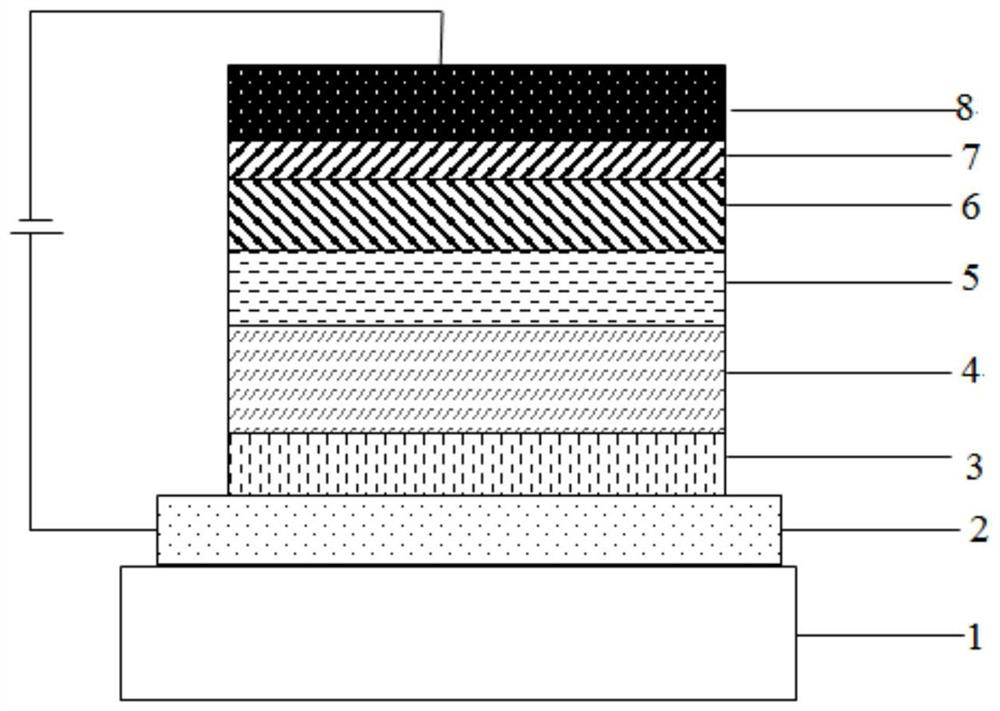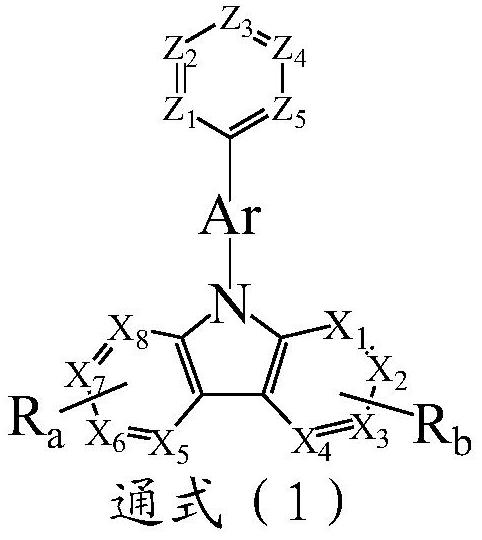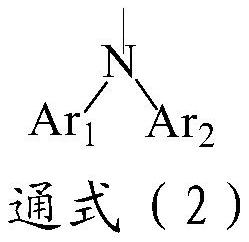A compound with azabenzene as the core and an organic electroluminescent device
An electroluminescent device, azabenzene technology, applied in the field of semiconductors, can solve the problems of low S1 state radiation transition rate, difficult exciton utilization rate, high fluorescence radiation efficiency, efficiency roll-off, etc., to achieve good film-forming properties Effects of fluorescence quantum efficiency, avoidance of aggregation, and mitigation of efficiency roll-off
- Summary
- Abstract
- Description
- Claims
- Application Information
AI Technical Summary
Problems solved by technology
Method used
Image
Examples
Embodiment 1
[0096] The synthesis of embodiment 1 compound 1
[0097]
[0098] The concrete synthetic route of this compound is provided now:
[0099]
[0100] In a 250ml four-neck flask, under a nitrogen atmosphere, add 0.01mol 4-(4-bromophenyl)-2,6-bis-(4-tert-butylphenyl)-pyrimidine, 0.015molN,N, N',N'-Tetra-p-benzyl-9H-carbazole-3,6-diamine, 0.03mol sodium tert-butoxide, 1×10 -4 mol Pd 2 (dba) 3 , 1×10 -4 mol of tri-tert-butylphosphine, 150ml of toluene, heated to reflux for 24 hours, sampling plate, showing no bromide remaining, the reaction was complete; naturally cooled to room temperature, filtered, and the filtrate was subjected to vacuum rotary evaporation (-0.09MPa, 85°C), After passing through a neutral silica gel column, the target product was obtained with a purity of 99.80% and a yield of 62.20%.
[0101]HPLC-MS: The theoretical value is 975.52, and the measured value is 975.68.
Embodiment 2
[0102] The synthesis of embodiment 2 compound 5
[0103]
[0104] The concrete synthetic route of this compound is provided now:
[0105]
[0106] In a 250ml four-neck flask, add 0.01mol 4-(3-bromophenyl)-2,6-bis(4-tert-butylphenyl)-pyridine, 0.015molN,N,N ',N'-Tetra-p-benzyl-9H-carbazole-3,6-diamine, 0.03mol sodium tert-butoxide, 1×10 -4 mol Pd 2 (dba) 3 , 1×10 -4 mol of tri-tert-butylphosphine, 150ml of toluene, heated to reflux for 24 hours, sampling plate, showing no bromide remaining, the reaction was complete; naturally cooled to room temperature, filtered, and the filtrate was subjected to vacuum rotary evaporation (-0.09MPa, 85°C), After passing through a neutral silica gel column, the target product was obtained with a purity of 95.76% and a yield of 58.00%.
[0107] HPLC-MS: The theoretical value is 974.53, and the measured value is 974.65.
Embodiment 3
[0108] The synthesis of embodiment 3 compound 8
[0109]
[0110] The concrete synthetic route of this compound is provided now:
[0111]
[0112] In a 250ml four-neck flask, under a nitrogen atmosphere, add 0.01mol 4-(4-bromophenyl)-2-dibenzofuran-4-yl-6-phenyl-pyridine, 0.015molN,N,N ',N'-Tetra-p-benzyl-9H-carbazole-3,6-diamine, 0.03mol sodium tert-butoxide, 1×10 -4 mol Pd 2 (dba) 3 , 1×10 -4 mol of tri-tert-butylphosphine, 150ml of toluene, heated to reflux for 24 hours, sampling plate, showing no bromide remaining, the reaction was complete; naturally cooled to room temperature, filtered, and the filtrate was subjected to vacuum rotary evaporation (-0.09MPa, 85°C), After passing through a neutral silica gel column, the target product was obtained with a purity of 98.63% and a yield of 82.80%.
[0113] HPLC-MS: The theoretical value is 952.41, and the measured value is 952.52.
PUM
| Property | Measurement | Unit |
|---|---|---|
| thickness | aaaaa | aaaaa |
| thickness | aaaaa | aaaaa |
| thickness | aaaaa | aaaaa |
Abstract
Description
Claims
Application Information
 Login to View More
Login to View More - R&D
- Intellectual Property
- Life Sciences
- Materials
- Tech Scout
- Unparalleled Data Quality
- Higher Quality Content
- 60% Fewer Hallucinations
Browse by: Latest US Patents, China's latest patents, Technical Efficacy Thesaurus, Application Domain, Technology Topic, Popular Technical Reports.
© 2025 PatSnap. All rights reserved.Legal|Privacy policy|Modern Slavery Act Transparency Statement|Sitemap|About US| Contact US: help@patsnap.com



